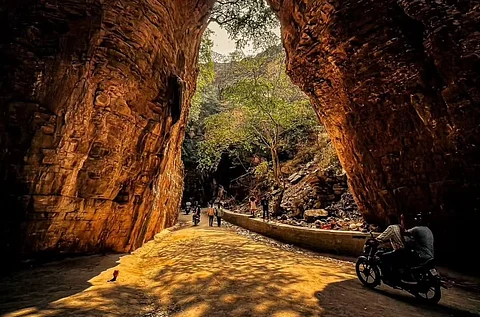
- Destinations
- Experiences
- Stay
- What's new
- Celebrating People
- Responsible Tourism
- CampaignsCampaigns
- SubscribeSubscribe
- Buy Now

When visiting Andhra Pradesh, explore a breathtaking natural wonder: the Billasurgam Caves. Located about 280 km from Hyderabad, these caves have jaw-dropping limestone corridors and natural rock cathedrals. Here you can experience the echoes of a time when prehistoric humans roamed these areas.
The caves, located in the Betamcherla Mandal of Kurnool district, are a lesser-explored tourist destination just a short five hour-long road trip away from Hyderabad. They stand as a testament to the artistry of nature, sculpted over countless millennia by the gradual dissolution of limestone. This intricate geological process has birthed a labyrinth of tunnels, expansive cathedral-like chambers, and winding passageways that seem to whisper secrets of the earth's ancient past. The ossiferous cave complex is recognised for having the longest record of archaeological and palaeo-environmental exploration of any cave system in India, with studies commencing in the first half of the 19th century. These natural wonders, characterised by their stunning rock formations and intricate cave systems, offer a glimpse into the geological history of the region.
The engraving found in the Billasurgam Caves is said to be the first in India to be directly dated, with an estimated age ranging between 4,100 and 5,400 years. This dating enables archaeologists to better understand the chronology and evolution of Indian rock art, as well as its connection to various cultural and environmental changes. They feature cave art and artifacts that date back to the mid-Holocene period, indicating Mesolithic or early Neolithic origins. Notably, a petroglyph with nested diamond designs was radiocarbon dated to around 5,000 years before present (cal BP). Some researchers propose that the cave art may be several centuries younger.
Discovered in 1884 by British geologist Robert Bruce Foote, the caves near Pallavaram are significant for their archaeological findings. Foote uncovered Paleolithic stone tools, bone tools, and animal remains, indicating human habitation from the Upper Paleolithic period. The artifacts, including chisels, spearheads, and scrapers, suggest that these caves were vital for early human communities engaged in activities like hunting and tool-making. Today, the caves remain a focus of academic research and conservation efforts aimed at preserving their historical importance.
Despite their historical importance and scenic beauty, the Billasurgam Caves have not yet attracted the attention they deserve from tourists and researchers alike, leaving them a hidden gem waiting to be explored.
The ideal time to visit the Billasurgam Caves is between October and March, when the weather is cooler and more pleasant for exploration. Visiting during this period allows for a more enjoyable experience in the caves and their surrounding area. In contrast, the monsoon season, which lasts from June to September, can make access challenging and the weather less favourable.
The nearest airport to Billasurgam Caves is Visakhapatnam Airport, which is approximately 60 km away. The nearest train station is Vizianagaram Junction, about 2.7 km from the caves, and the nearest bus stand is Vizianagaram Bus Stand, also about 2.7 km away.
